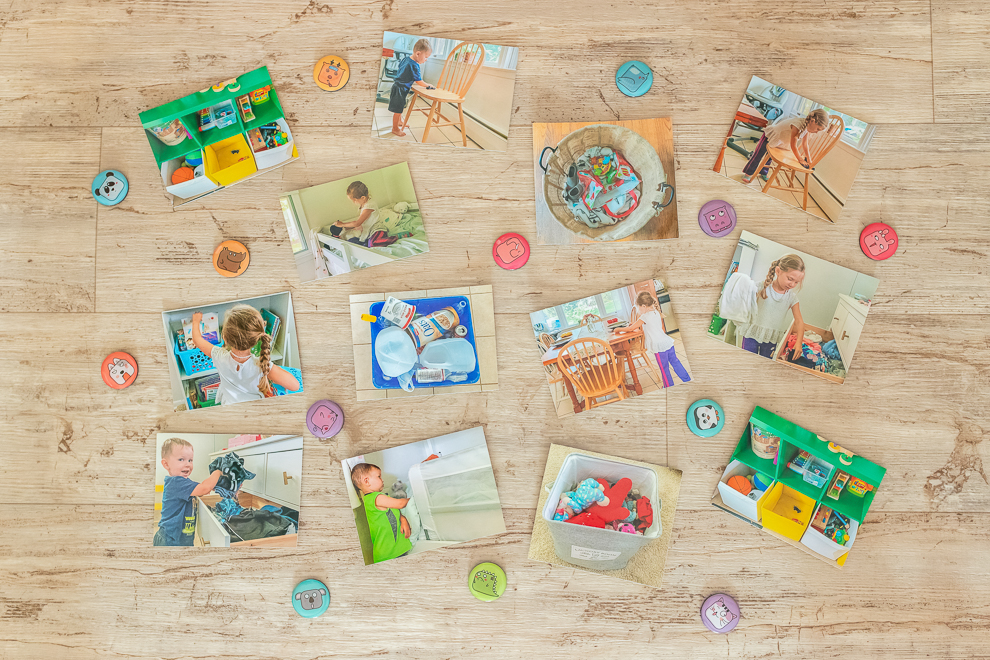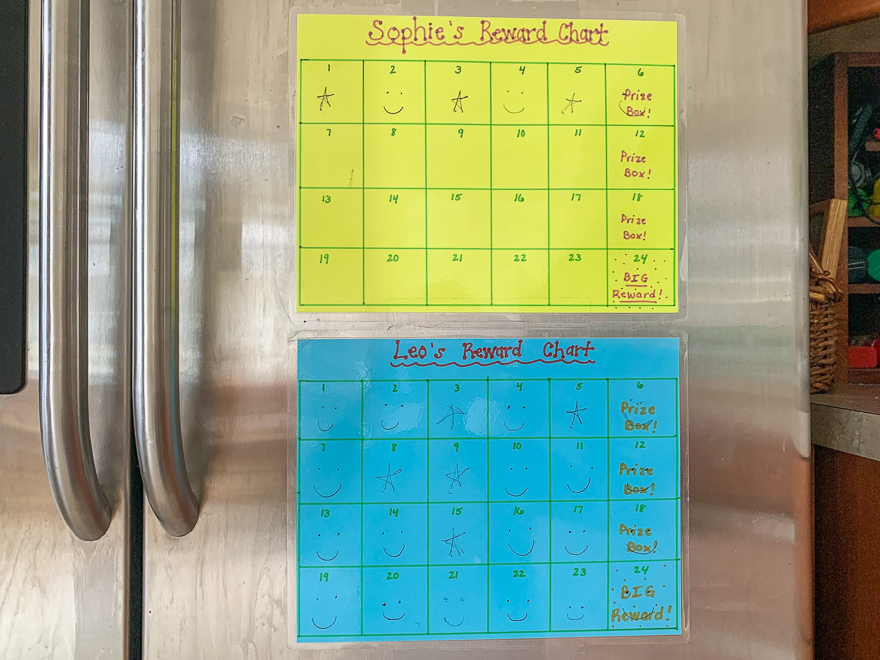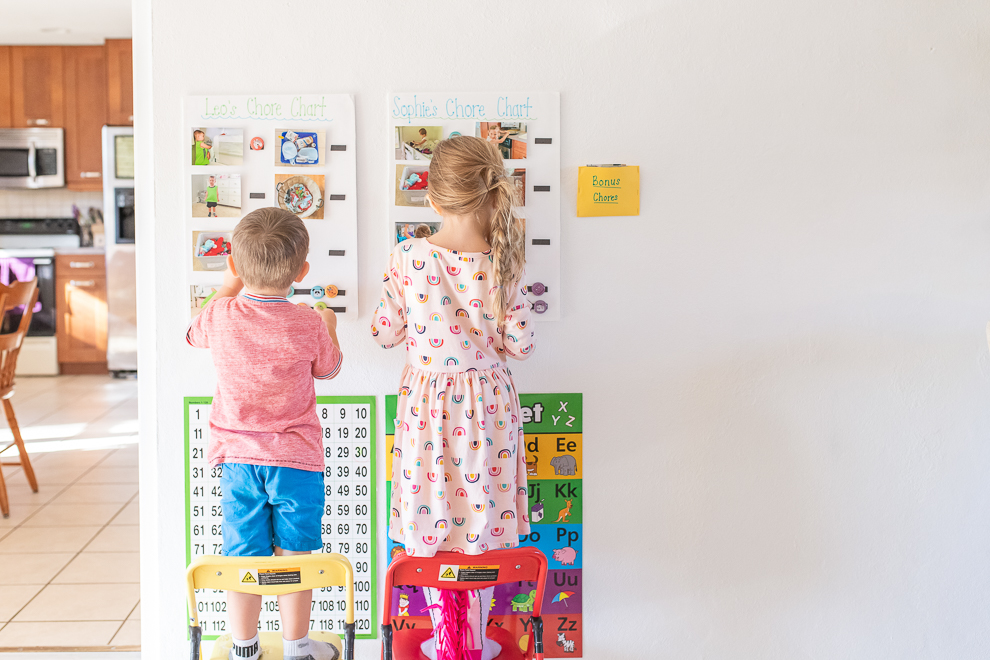Created by Mike & Mollie. Subscribe to our blog.
As our toddler children were getting older and becoming more independent, we realized that they were old enough to start doing some basic chores around the house.
Up to that point, I had no rhyme or reason for the hodge podge of chores that I was dishing out to them each day, but I thought that if they completed one act of helpfulness (of my choosing) per day, that would equip them to be able to do more in the coming years.
It wasn’t sustainable.
They didn’t know what to expect each day with me randomly choosing something for them to clean up, put away, or organize. The jobs weren’t done very well because there wasn’t much consistency. And I felt frustrated at the results and eventually sent them off to play as I finished doing the chore the correct way.
Making a chore chart
When I finally decided to create the kids’ chore chart, I put a lot of thought into it because I wanted it to be sustainable and for the kids to learn the goal behind having them do chores.
After many searches on Pinterest for chore chart ideas, I couldn’t settle on one that suited all of our needs. I needed a chore chart that had the following elements in order for it to work best for our family:
- Pictures instead of words for non-readers
- The ability to have my children do certains chores on different days of the week
- Images that displayed more specific chores (ex. cleaning underneath the bed)
- The ability to rotate chores in and out according to different seasons
I wanted my kids to look at their chart and know exactly what chore they had to do. So I decided to take my own pictures of them doing each job. My logic behind this process is that if they could see a picture of themselves doing it, they would know what was to be done.

I decided to hang their charts in our playroom where most of our homeschooling items are so that we would see it and be reminded of it throughout the day. I didn’t want a whole day to go by and have forgotten to remind them about their chores.
I used a piece of foam board as the base, so it was sturdy enough to withstand little hands constantly touching it. I placed each picture card of the chore on the board with a magnetic strip on the back. That way I could easily swap cards around and replace them with new chores as needed.
Then I placed another magnet strip next to each picture card. An animal magnet would be placed on this spot when the chore was completed. I knew my kids would be really excited about fun magnets, so we bought these from Amazon.
When thinking about making a chore chart for your children, consider these questions:
- Where will you place it?
- What material do you want to use to make it?
- Will you use pictures or words?
- How many chores will each child have?
- Are those chores something that is beneficial for your family or just more work for you?
- Will you give an incentive? What will that be?
Our reward system
We wanted our chore system to create a balance between intrinsic motivation (the satisfaction of completing all their chores and pleasing their parents) and extrinsic motivation (a word or praise or a prize, such as movie time).
We’ve used different types of rewards for our chore chart but I feel like the most consistently motivating reward is a sticker/star chart. We use a 24-box chart on colored paper.

Each day they complete their chores, they get a star or smiley face. They also earn these for good work with homeschooling and times that we notice great behavior. Every 6th box earns them a small reward. This is either tv time or a prize from the prize box. When they complete their whole chart, a bigger reward is given.
Appropriate chores for kids
One of the biggest questions about chores for children is, “What chores are age-appropriate for my child?”. Pinterest will give you lists of age appropriate chores which is a great starting point. However, you have to remember that chores will only be effective if it works for your family in this season of life.
One way to determine which chores are appropriate for your child is by catering to their interests. Our 5 year old daughter is more apt to keeping things organized and tidy, so vacuuming the kitchen after dinner and organizing the books in her bedroom are good ones for her, not necessarily for our 3 year old son.
Praise, don’t just critique
In the process of teaching your child how to do the chore well, praise them often along the way. Instead of telling them every minute to keep cleaning up toys, praise them for even the smallest amount of progress they’ve made.
Words of affirmation, excitement, hugs, kisses, and high-fives go a long way. From my experience, my children are much more motivated when I show them that I’m proud of their work and effort.
Have realistic expectations
My children are not perfect at organizing a bookshelf, making a bed, or placing clothes neatly in their drawers. And since I know they are just kids and not a hired maid service, I can’t expect perfection either.
However, there do need to be some realistic expectations when it comes to doing the chores we’ve given them. There are two things that we ask of our children as they do their chore:
- No complaining about doing the chore
- Do a thorough job (not perfect, but their best effort)
Since the chores we give our children are age-appropriate, another key expectation is to let them do it how a child their age is able to. Avoid trying to fix their mistakes to make it perfect. A lumpy bed is okay. A clothing drawer that is not in pristine piles is fine.
But you can’t start out the process with thinking they’ll be able to do these chores well. Like any new skill, kids need to be taught how to do them. For the first few weeks (or even months for younger children), do the chore with your child. Show him or her the expectation for doing it well. Don’t do it for them while they watch, do it together so they learn.
It’s time consuming, for sure, but makes a big difference in teaching them how to do it correctly and independently.
Adding a chore chart to our daily routine has been a great way to teach our kids how to be more responsible and contribute to our family. We’re not quite at the point where having them do chores saves me time, but I am certainly looking forward to that day!
🌿 Introducing, Declutter Your Life, a premium newsletter with monthly challenges to help you live a less cluttered life– inside and out.




